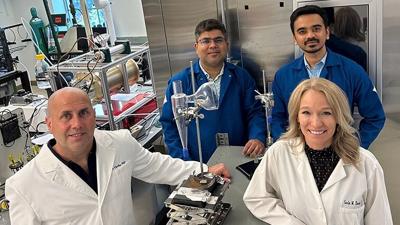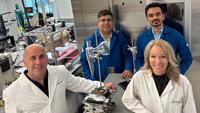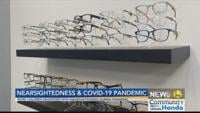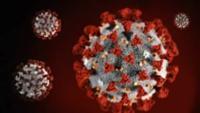Toronto, Canada (CTV Network) -- Imagine if, after spending just five minutes in a room, you could determine whether or not there were any live viruses drifting through the air.
Researchers say they have created a device that can do just that—detect COVID-19 in the air in a matter of minutes—and it may be able to detect other respiratory viruses such as influenza and RSV in the future.
“There is nothing at the moment that tells us how safe a room is,” John Cirrito, a professor of neurology at the School of Medicine at Washington University and one of the researchers who created the device, said in a press release. “If you are in a room with 100 people, you don’t want to find out five days later whether you could be sick or not. The idea with this device is that you can know essentially in real time, or every five minutes, if there is a live virus in the air.”
If it does everything it’s designed to do, it could be a game-changer for long-term management of COVID-19, researchers say.
It would be able to inform the public if a crowded indoor gathering was free of viral risk, or allow health-care professionals in a hospital setting to speedily identify if viruses were threatening their patients’ safety.
The device, which researchers say is inexpensive to make, is around the size of a football and lights up when a virus is detected, alerting those in the room quickly.
It was created by a team that included medical researchers and engineers at Washington University.
The first proof-of-concept version of the device was described in a paper published Monday in the peer-reviewed journal Nature Communications.
“We are starting with SARS-CoV-2, but there are plans to also measure influenza, RSV, rhinovirus and other top pathogens that routinely infect people,” Cirrito said. “In a hospital setting, the monitor could be used to measure for staph or strep, which cause all kinds of complications for patients. This could really have a major impact on people’s health.”
The biosensor that makes up a key element of the design comes from previous work done by Cirrito and Carla Yuede, an associate professor of psychiatry at the School of Medicine.
They had developed a micro-immunoelectrode (MIE) biosensor to pick up a biomarker for Alzheimer’s disease, amyloid beta. When the COVID-19 pandemic hit, they began to wonder if the design could be repurposed to detect SARS-CoV-2, and so this new project was born.
Researchers had to swap out the antibody that recognizes amyloid beta for something that could recognize COVID-19 instead. A nanobody, which is a small antibody fragment, was developed by David Brody, a former faculty member in the Department of Neurology at the School of Medicine, at his lab at the National Institutes of Health.
“The nanobody-based electrochemical approach is faster at detecting the virus because it doesn’t need a reagent or a lot of processing steps,” Yuede said. “SARS-CoV-2 binds to the nanobodies on the surface, and we can induce oxidation of tyrosines on the surface of the virus using a technique called square wave voltammetry to get a measurement of the amount of virus in the sample.”
Tyrosines are one of the amino acids that cells use to synthesize proteins.
Once the biosensor had been recalibrated to detect COVID-19, researchers combined it with a specific air sampler which works by sucking air in quickly and mixing it with fluid on the inside of the sampler in order to trap virus aerosols.
That fluid is then checked by the biosampler to see if there are any viral particles present.
This “wet cyclone” style of air monitoring allows for researchers to search for the tiniest trace of virus, researchers say.
“The challenge with airborne aerosol detectors is that the level of virus in the indoor air is so diluted that it even pushes toward the limit of detection of polymerase chain reaction (PCR) and is like finding a needle in a haystack,” Rajan Chakrabarty, an associate professor of energy, environmental & chemical engineering in McKelvey Engineering at Washington University and study author, said in the release.
“The high virus recovery by the wet cyclone can be attributed to its extremely high flow rate, which allows it to sample a larger volume of air over a 5-minute sample collection compared with commercially available samplers.”
Their prototype has a flow rate of around 1,000 litres per minute.
In order to see if the device worked, researchers placed the device in two apartments that belonged to people who were confirmed to have COVID-19 at the time of the test.
They then compared the results of that air sampling with samples of air collected from a virus-free room, in order to see if the device correctly identified the presence — and absence — of COVID-19.
The devices detected COVID in the infected apartments, but did not react to air from a virus-free room.
The infected people who owned the apartments stated they weren’t experiencing symptoms at the time of the sampling, and the data collected suggests that there was only low viral shedding by these volunteers, according to the paper, showing the sensitivity of the device.
Researchers also tested the device in a chamber filled with aerosolized SARS-CoV-2 to see if the device could detect varying levels of virus concentrations, and found it could after only a few minutes.
The emergency phase of the COVID-19 pandemic was declared by the World Health Organization to be over in May, citing a significant decline in weekly deaths and hospitalizations, as well as the positive impact of vaccination campaigns.
However, that doesn’t mean that we can forget about COVID-19 completely — the virus does still exist, and can still cause serious illness or death, especially for immunocompromised or otherwise high-risk populations, according to researchers. What exiting the emergency phase means is that health organizations have been advised to pivot to long-term management of the virus.
Long-term COVID management requires monitoring for outbreaks or new variants that could evade vaccine protection.
A device that can monitor the air for viruses could be invaluable in a health-care setting, and could also help to make spaces more accessible to those who are in high-risk categories for COVID-19 and may still be wary of crowded gatherings, according to the study.
The paper explained that while there was a variability in the device’s sensitivity depending on the strains of SARS-CoV-2 in the air due to differences in the spike proteins between variants, the device was still sensitive enough to discern the presence of the virus regardless of variant.
While the prototype isn’t quite ready to be widely distributed for use, the team is looking to commercialize the device. To develop it further, researchers want to test it in multiple settings with very different aerosol compositions in order to see if the device can still accurately detect a live virus in the air without being confounded by any “potential interfering agents.”
There’s also one major drawback so far: the noise.
According to the paper, the device makes a lot of sound while in use, but this is something that designers are working to address, possibly by using a low-noise motor and “soundproofing the device exterior using an acoustic liner.”












